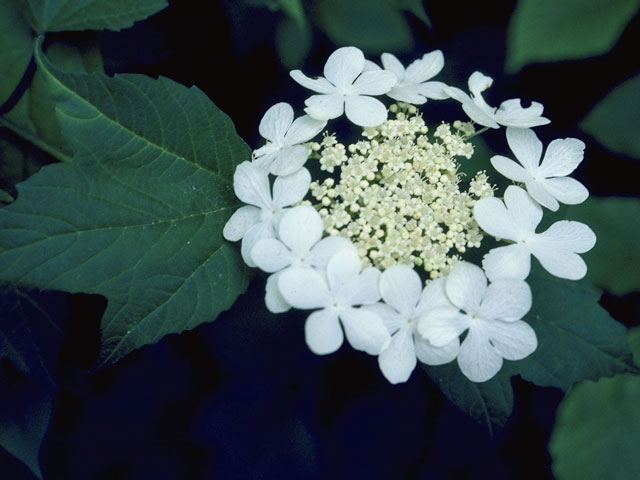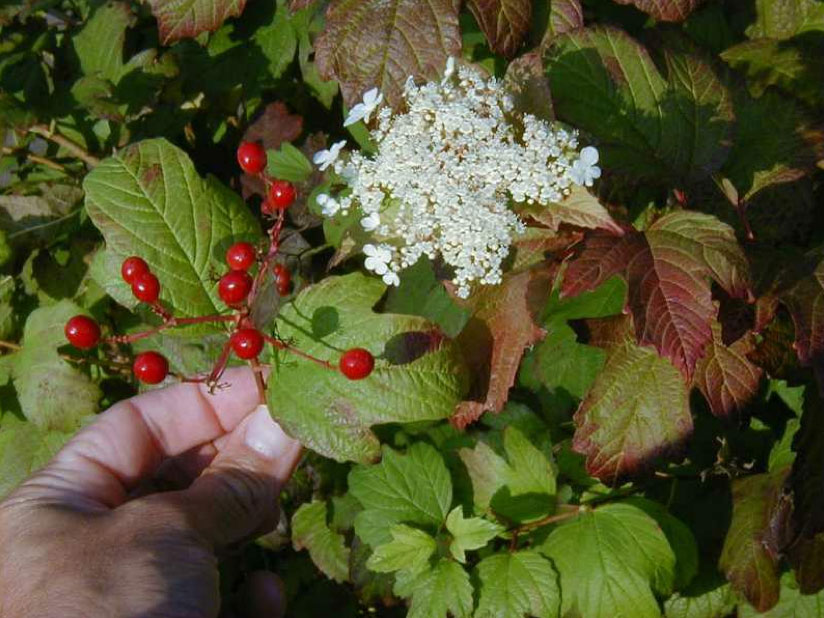American Cranberry Bush
Viburnum trilobum is a beautiful shrub that grows small, edible red berries and white flowers when in bloom.
Scientific Name: Viburnum trilobum (syn. Viburnum opulus var. Americanum)
Common Name: American Cranberry Bush; Mooseberry; High Bush Cranberry; American Cranberry Bush
Viburnum, Cranberry Viburnum
Plant Family: Adoxaceae (Moschatel Family)
Etymology: Viburnum opulus comes from the Latin word viburnum (“wayfaring tree”) and opulus which comes from the Gaulish word opolos (“maple”). “Var. Americanum” is the Latin phrase to distinguish that the plant is from America (Viburnum opulus has a European form).
Indigenous Uses
Native Americans, particularly the Ojibwe (Chippewa) tribe, used the edible berries both as a food and for its medicinal properties. Viburnum opulus var. Americanum was consumed during the winter months for its high volume of vitamin C either raw, baked into food items such as cakes, or dried and added to relishes or syrups. The roots were also infused to be utilized for certain medical issues such as prolapses of the uterus and other gynecologic issues. The Ojibwe tribe often used the berries as bait for snares meant to trap rabbits as well.
Edible Parts
The berries of the Viburnum opulus var. Americanum are the primary edible portions of the plant. Although they should not be eaten in large quantities due to their mild toxicity (could cause upset stomach in large amounts), they can be eaten raw or cooked into jams and jellies. They are best to be eaten when ripe, after the first freeze as they tend to have a sweeter taste during this period. Typically, after multiple freezes, the berries shrivel and have a bitter taste. The maple-like leaves can also be brewed to make tea. The white flowers can be added into desserts to add sweetness and edible decoration as well.
Gathering and Using
Typically, where the High Bush Cranberry is located there are large quantities of plants and berries surrounding the area. For the most optimal taste, berries should be collected just after the first frost, preferably in the early morning. In order to make preserves, jams, and jellies, large quantities of berries should be collected since the berries are usually only 12mm. The plant should also be observed for aphids and powdery mildew as this could indicate disease or bacteria that should not be eaten. The berries hang from the branches of the plant and can be plucked off. After cleaning the berries, they can be eaten raw or cooked. The leaves can be boiled or steeped in cold water for tea. The flowers are often used to add sweetness to food items.
Permaculture Functions and Considerations
Medicinal uses, high concentrations of vitamin C, an important source of food for wildlife, erosion control, windbreak, landscaping, aesthetic, and nutrient dense food for humans. Often used for screening and as borders in landscaping. Also, they are considered a winter survival food because the berries stay above the snow and often taste better after freezing.
Habitat
You can expect the American Cranberry Bush to grow in moist to wet soil with well-drained loams in areas with partial shade to full sun. Although it thrives in these conditions, it can survive in poorly drained soil as well so long as the soil is not in drought.
How to Identify
The American Cranberry Bush is a large, dense shrub that can range from 8-12 ft tall and has a spread of 8-12 ft. The leaves are 3-lobed, dark-green, and opposite with an appearance similar to a maple leaf. During autumn, the leaves have a red coloration. The blooming period occurs from late April to July and white lacecap flowers can be found on the bush with a larger outer ring of flowers and an inner ring of smaller flowers. The berries, which ripen in September and October and remain throughout the winter, have an appearance similar to cranberries but are almost translucent when ripe. There is also a European form of the cranberry bush (Viburnum opulus) that is invasive in the U.S. and very similar to Viburnum opulus var. Americanum. This form has inedible fruit and contrasts from the American form in which its petiolar glands (where the leafstalk joins the leaf blade) curve inward whereas the American form has petiolar glands that protrude outwards.
 Bransford, W.D. and Dolphia. Wildflower Center Slide Library. April 1994.
Bransford, W.D. and Dolphia. Wildflower Center Slide Library. April 1994.

Missouri Botanical Garden, Accessed February 18, 2022.
Wildlife Support
The American Cranberry Bush is an essential food source for wildlife including songbirds, gamebirds, and small mammals. The fruit of the shrub is consumed by many birds such as Cedar Waxwings, Robins, and Hermit Thrush. It also serves as a host plant for the larvae of butterflies and moths, especially the Spring Azure (Celastrina ladon). The white flowers attract pollinators when in bloom.
Additional Information
The American Cranberry Bush often has a symbiotic relationship with predatory insects. The glands on its leaf stem generate sweet nectar that is attractive to insects such as wasps, ants, and some flies. These insects protect the plant from harmful caterpillars and other insects by hunting them while collecting the nectar.
Sources
- Arbor Day Foundation. “American Cranberrybush Viburnum.” arborday.org. Accessed February 18, 2022.
- Armstrong, Charles. “Highbush Cranberry (not a true cranberry).” University of Maine. Cooperative Extension: Cranberries. Accessed February 18, 2022.
- Beadle, David; Leckie, Seabrooke. Peterson Field Guide to Moths of Northeastern North America.
- Gilmore, Melvin R., 1933, “Some Chippawa Uses of Plants.” Native American Ethnobotany DB. Ann Arbor. University of Michigan Press, page 141.
- Levine, Carol. A Guide to Wildflowers in the Winter.
- Petterson, Lee Allen. A Field Guide to Edible Wild Plants of Eastern and Central North America.
- Sweet, Hannah. “The Story of the American Cranberrybush.” Eat the Planet, February 2021.
- The Morton Arboretum. SEINet Arizona-New Mexico Chapter. “Viburnum opulus var. Opulus.” org. Accessed February 19, 2022.
- TWC Staff. Lady Bird Johnson Wildflower Center. University of Texas Austin. “Viburnum opulus var. Americanum.” org, September 2016.
- USDA NRCS Plant Materials Program. USDA NRCS. “American Cranberrybush Fact Sheet.” Plants.usda.gov, February 2002.